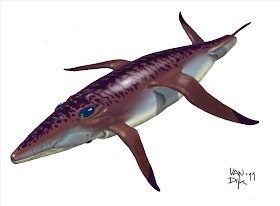To be more precise, it is a Fusus rostrauctus of the Clade Fishes IV (Proculcapiti). I may have to check naming conventions here though. Anyway, I revealed a glimpse of Fish evolution previously, which I will not repeat. You may observe the typical traits of the Clade, but I will focus on artistic matters here (just as well, as there were some sudden changes in their anatomy compared to the rough sketch in the earlier post!). Having done a fairly large number of full paintings in oils for the eventual Book, I felt I needed additional illustrations, highlighting individual species, cladograms, things like that. This is the first of those. I wished to keep the painting style more or less the same as that of my previous oil paintings, and think I managed. After messing about with Painter's very large assortment of brushes, I settled on just two, and used those throughout (for those in the know, I used a detail oil brush and a blender, but tweaked size, opacity, 'resaturation' and 'bleed' continuously).
Just for fun I will show some layers of the final painting. The nice thing with digital painting is that you can use layers of colour that stay separate, so you can go back to a deep layer even after you painted others over it. In a 'real' painting ('physical' painting?) the only way to correct a deep layer is to scrape it, and everything on top of it, away altogether.
So here is the start of my project (it's not a tutorial: I'm not good enough for that). I started with a rough sketch and simply changed lines and shapes until the concept became more or less ready; that is the image on the left. I then drew a much neater line drawing on another layer, and used that as a guide for the painting job: the one on the right. In old times, I would have done exactly the same, but using various sheets of paper for the sketches on the left and one sheet of transparent paper for the one on the right.
After that you start painting. In this case I chose flat colours to start with. With oils, this basic colour layer would have obscured the line drawing on the board. Digitally, things are different: you can paint underneath your sketch, so that stays visible. Very odd at first, but extremely useful. The base colours are on the left, but without the line drawing. After that, another layer was added (on the right), and that is where it becomes interesting: that one modifies the base colours with shadows and highlights, as well as with some subtler colour changes here and there.
After that I decided to add another colour layer (I should have done that before, but, as I said, I am new at this). The rest comprises adding some reflections, details, some final shadows etc., and there we are. Mind you, the original is almost 7 times bigger, so some detail is lost. Anyway, here's my first digital painting. I hope you like it.




That's an amazing painting, it's always great to see new creatures from you.
ReplyDeleteIt's sad to hear that you're going to be cutting down on blogging though :(
I really hope you'll be painting new creatures soon!
ReplyDeleteHi Anonymous, working on one right now...
ReplyDeleteIve been looking through your site and on your blog for a while now and I must say that Im amazed, the work you do is right up my alley, I love speculative biology and the near infinite possibilties that it grants you.
ReplyDeleteSwitching over to digital painting is horrific at first, dont be surprised if you even end up going back to traditional for a while, I found the first year or so very difficult and frustrating but once you start to get the hang of it progress speeds up in ways that traditional media just cant.
By the way are you familiar with Theo Jansen? I remember you were asking in an older post about other speculative biology related articles and works, this guy has actually developed synthetic life forms that run on wind energy. Im pretty sure theres some vids of his work on You tube.
Marco.
Hello Marco,
ReplyDeleteThank you for the encouraging words. I just had a quick look at your blog, and I will be back later for a closer and longer look. Very nice work!
About Theo Jansen: I know his work, and have actually seen his devices in action:
http://planetfuraha.blogspot.com/2009/11/walking-machines-iii-abiological-ones.html
http://planetfuraha.blogspot.com/2010/08/strandbeesten-and-mantis-shrimps.html
How long has life on Furaha been evolving? Do your aliens use DNA?
ReplyDeleteAnonymous: about 3*10^9 years, I guess. And there is no DNA as suc, but there is a 'REM': a 'Replicating Encoding Molecule'. Basically, it does the same trick, just not with nucleotides (I never thought too much about what should take their place).
ReplyDeleteI've been working on my own speculative project. Instead of using keratin as weapons my carbon based aliens use silicon instead.Is this even possible? Having crystal weapons? After all, a certain type of one celled organism uses silicon to protect it.
ReplyDeleteAnonymous,
ReplyDeleteI'm not very knowledgeable about astrobiochemistry, but what I have read suggests that silicon-based life would work well at low temperatures, and that does not mean polar on earth, but more like a few degrees above absolute zero... Also, no oxygen, and some other weird conditions.
Here are some papers: http://journalofcosmology.com/SearchForLife120.html
http://geog-www.sbs.ohio-state.edu/courses/G820.01/SP06/Schulze-Makuch%20and%20Irwin_20%202.pdf